Suchergebnisse für "Factsheet%3A Energietechnologien gestalten%2C die f%C3%BCr alle sinnvoll und nutzbar sind"
Fibre composites with natural adhesive
Developing of suitable bonding agents, fibres and processing technologies for the production of form stable fibre composites made of natural components. Production of prototypes like boards and moulded parts. Material testing.
The Paper Factory in the Year 2030
Paper factory in the year 2030 as an integrated part of a sustainable economy and a supplier of sustainable paper products fulfilling criteria for sustainability at highest possible level.
IEA Hydrogen (Hydrogen TCP)
The Hydrogen TCPs coordinates joint R&D activities with the aim of advancing the development and deployment of safe and sustainable technologies for the production, storage and supply of clean and affordable hydrogen and its derivatives for use in industry, mobility, heating and electricity.
Erfolgreiche Beispiele aus der Programmlinie Fabrik der Zukunft
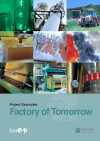
Herausgeber: Bundesministerium für Verkehr, Innovation und Technologie (BMVIT)
Englisch, 36 Seiten
Downloads zur Publikation
smartEXT - extended application boundaries for proven passive house technology
The present study aims to explore the application options for compact units (ventilation devices including micro heat pumps, developed for passive houses) in low energy buildings. Compact ventilation units for heat recovery, heating and domestic hot water shall bear the basic heating load, whereas peak loads shall be covered by newly-developed auxiliary heating equipment combined with intelligent control algorithms. This allows increased energy efficiency as well as cost effectiveness together with higher living quality and lower ecological load.
Field test of a virtual power Plant comprising 30 pellet-boiler fired micro-CHP modules
A virtual biomass plant comprising 30 micro-CHP-Modules, each of them integrated into an existing pellets-boiler in the Austrian region of eastern Styria is to be tested. The goal of this project is to gain experience and to introduce a new sustainable technology.
Aufarbeitung von Filterrückständen bei der Bierherstellung zur Gewinnung einer innovativen pharmazeutischen Substanz
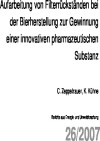
Schriftenreihe
26/2007
C. Zeppelzauer, K. Kühne
Herausgeber: Bundesministerium für Verkehr, Innovation und Technologie
Deutsch, 43 Seiten
Downloads zur Publikation
HY3GEN - A Regenerative Building
The "third generation hybrid building" (HY3GEN), whose main features are being defined in this project, has expanded this approach to include the integration of aspects of efficient resource utilization in construction and operation as well as the use of regenerative raw materials and renewable energy.
Development of a Cost-Benefit-Tool: costs and benefits of energy efficient and ecologic buildings
Development of a cost-benefit-tool which reaches beyond a pure cost approach and also recognizes the benefits of a building for its inhabitants and users. The inclusion of benefits is based on existing evaluation systems, especially on the Austrian building evaluation system TQB - Total Quality Building, which has been revised in 2009.
IEA Bioenergy Task 40: Deployment of biobased value chains (Working period 2022 - 2024)
Bioenergy Task 40 traditionally focused on international trade and supply chains of biomass for bioenergy. Starting in 2018, the systems view was broadened, also to better meet Austrian requirements. The supply chain focus was maintained, but with a broader premise: The establishment of bio-based value chains for a sustainable and fair bioeconomy.
Reporting about Sustainability: In 7 Schritten zum Nachhaltigkeitsbericht

Ein allgemeiner Leitfaden zur Nachhaltikeitsberichterstattung
Österreichisches Institut für Nachhaltige Entwicklung
Herausgeber: BMVIT - Bundesministerium für Verkehr, Innovation und Technologie
Deutsch, 56 Seiten
Downloads zur Publikation
Erstellung eines Konzeptes zur Entwicklung der "Dienstleistung Schmierung" zur Maximierung der Anlagenlebensdauer auf Basis von Ionischen Flüssigkeiten als Spezialschmiermittel
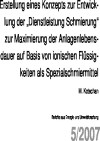
Schriftenreihe
05/2007
DI Dr. Michael Kotschan MBA
Herausgeber: Bundesministeriums für Verkehr, Innovation und Technologie
Deutsch, 43 Seiten
Downloads zur Publikation
Inter-linked design as a strategy towards sustainable buildings - removing deficiencies of learning and of diffusion

The aim is to investigate the role of inter-linked design team organisation in the design of sustainable buildings and to formulate ready-to-use recommendations and guidelines for dissemination.
Green Market Report Austria Compact - Facts and figures of green roofs and facades industry in Austria
First comprehensive data collection of installed green roof and green facades in Austria and exploration of current challenges and future growth potential für green roof and walls applications involving all stakeholders within the green industries value chain.
Straw pellets for small-scale combustion units
Assessment of the operation of straw pellets fired small-scale combustion systems. Investigation and assessment of different refractory materials with respect to corrosion and evaluation of primary and secondary measures to reduce gaseous and particulate emissions.
RepaMobil
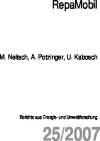
Abbau von Markthemmnissen bei haushaltsnahen Produkt-Dienstleistungs-Systemen, insbes. Reparaturleistungen, durch Servicestellen an Standorten mit hoher Kundenfrequenz
Schriftenreihe
25/2007
M. Neitsch, A. Potzinger, U. Kabosch
Herausgeber: Bundesministerium für Verkehr, Innovation und Technologie
Deutsch, 158 Seiten
Downloads zur Publikation
FABRIK der Zukunft Hintergrundband Teil 1, Auflage 1
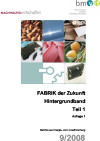
Sammlung von Projektergebnissen aus der Programmlinie FABRIK der Zukunft
Schriftenreihe
09/2008
Hans-Günther Schwarz, Mag. Sabine List
Herausgeber: Bundesministerium für Verkehr, Innovation und Technologie
Deutsch, 206 Seiten
Downloads zur Publikation
LTS Flywheel - Long Term Storage-Flywheel: New approaches for increasing the economically usable storage time and safety
Development of the fundamentals for a Long Term Storage (LTS)-flywheel for decentralized storage of electrical energy (e.g. from wind or PV power plants), with a significant increase in storage time (goal: 12 hours) and safety, featuring low system costs. Therefore, the LTS-Flywheel is an essential contribution to the building of the future.
PSS Strategies - Development of strategies for designing and implementing sustainable Product-Servicesystems
Based on a previous FdZ project it is intended to develop and implement strategies for sector specific sustainable product-servicesystems-innovations along product-chains in workshops with companies and other actors involved. Focus will be placed on implementation and possible restricting factors.
Countdown zum EASEY-Index
4. Juli 2002, 10:00-13:00 Uhr
Säulenhalle der Wr. BörseWallnerstrasse 8, 1014 Wien
Nachhaltigkeit - Eine Chance zur Belebung des Finanzmarktes Österreich
